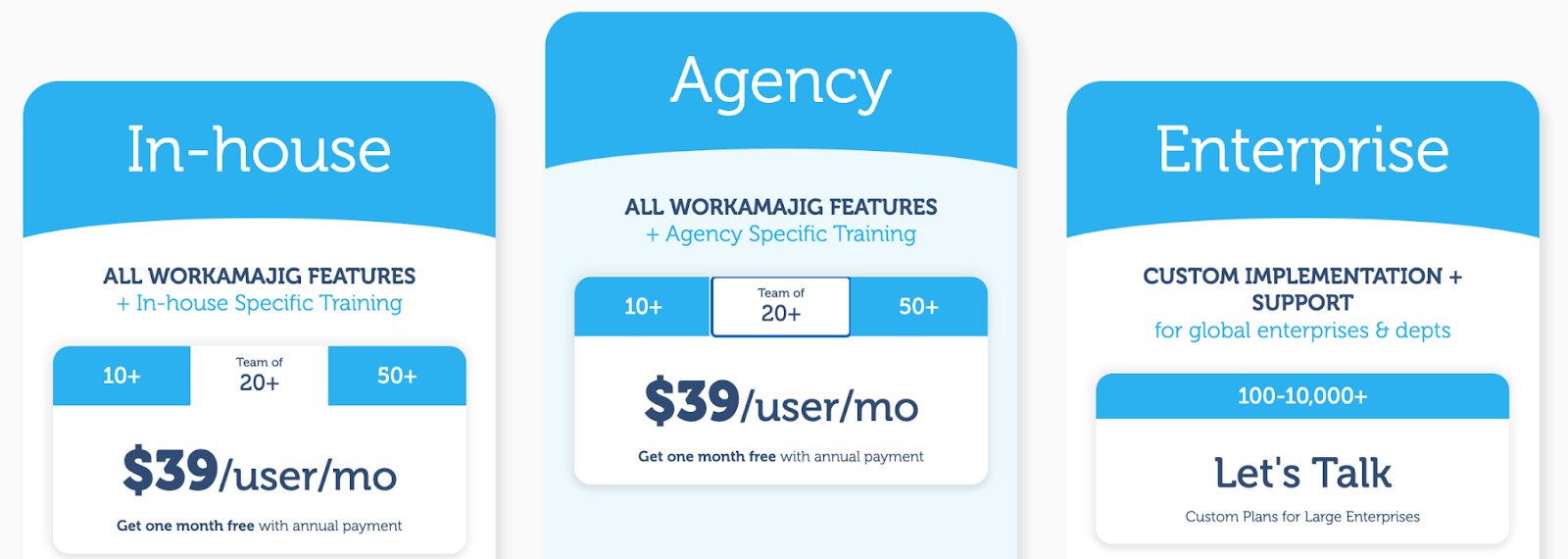There are dozens of project management software with time tracking tools (or that integrate with time tracking apps) — Trello, Jira, Wrike, Asana, Smartsheet, and Monday.com are popular names that are often mentioned.
However, these tools are all general project management tools that any project-based company can use; they’re not specifically designed for creative agencies or marketers, so they lack many of the features these teams need to track time effectively.
For example, they might let managers see the total number of hours someone worked on a project, but they don’t have tools to tie hours to employee rates, so managers can’t monitor budget usage as projects progress. If projects take longer than expected or managers don’t allocate resources strategically, they risk losing out on potential earnings (and can actually cost the agency money).
Creative and marketing teams need a project management tool that integrates the financial component of project planning and time tracking; this allows them to send more accurate estimates to clients, track and optimize project budgets, and guarantee project profitability.
Our software, Workamajig, is a creative project management tool designed with task, resource, and financial management to oversee each aspect of project planning. We’ve been working with creatives and marketers for 35 years, understanding what teams need to manage creative projects in one single source of truth, and have adapted our solution to support the best practices we’ve learned in our experience.
We created this guide to explain how our solution works and review four other top-rated project management tools (with time tracking) for creatives and marketers: Teamwork, Productive, Scoro, and My Hours.
Our guide covers the basics, but if you want to learn more about Workamajig after reading, you can request a free demo here.
1. Workamajig
Agency Management Software to Oversee Projects, Resources & Finances

Workamajig is a comprehensive project management tool designed with everything creatives need to plan and track projects strategically.
Our tool includes everything from project intake forms to client portals and financial reporting — it can replace full accounting systems, CRM systems, time tracking software, and other external systems teams typically use to support general project management tools.
When switching to Workamajig, we train you and your teams on how to use the software and help you customize features (like project templates) for your requirements. Then, you and your team members can work together in one system and make changes as you go.
The navigation and all features are intuitive and user-friendly, so there isn’t a lengthy learning curve.
Our solution is divided into two core modules:
- Project Management includes project setup, resource management, task management, time tracking, and project monitoring.
- Agency Management includes our finance and accounting tools, CRM system, and agency insights to manage invoicing and billing, analyze project profitability, and oversee all behind-the-scenes operations.
We’ll briefly explain how these modules work and how Workamajig supports creative team members. To explore our software further, you can request a personalized demo.
Workamajig Features to Support Project Management
Project Monitoring
Our dashboard clearly visualizes all your in-progress projects for easy monitoring. You can customize the view that suits you best.
Here, we display status updates on budgets and timelines so you can easily see if projects are at risk of running over and course-correct where necessary.
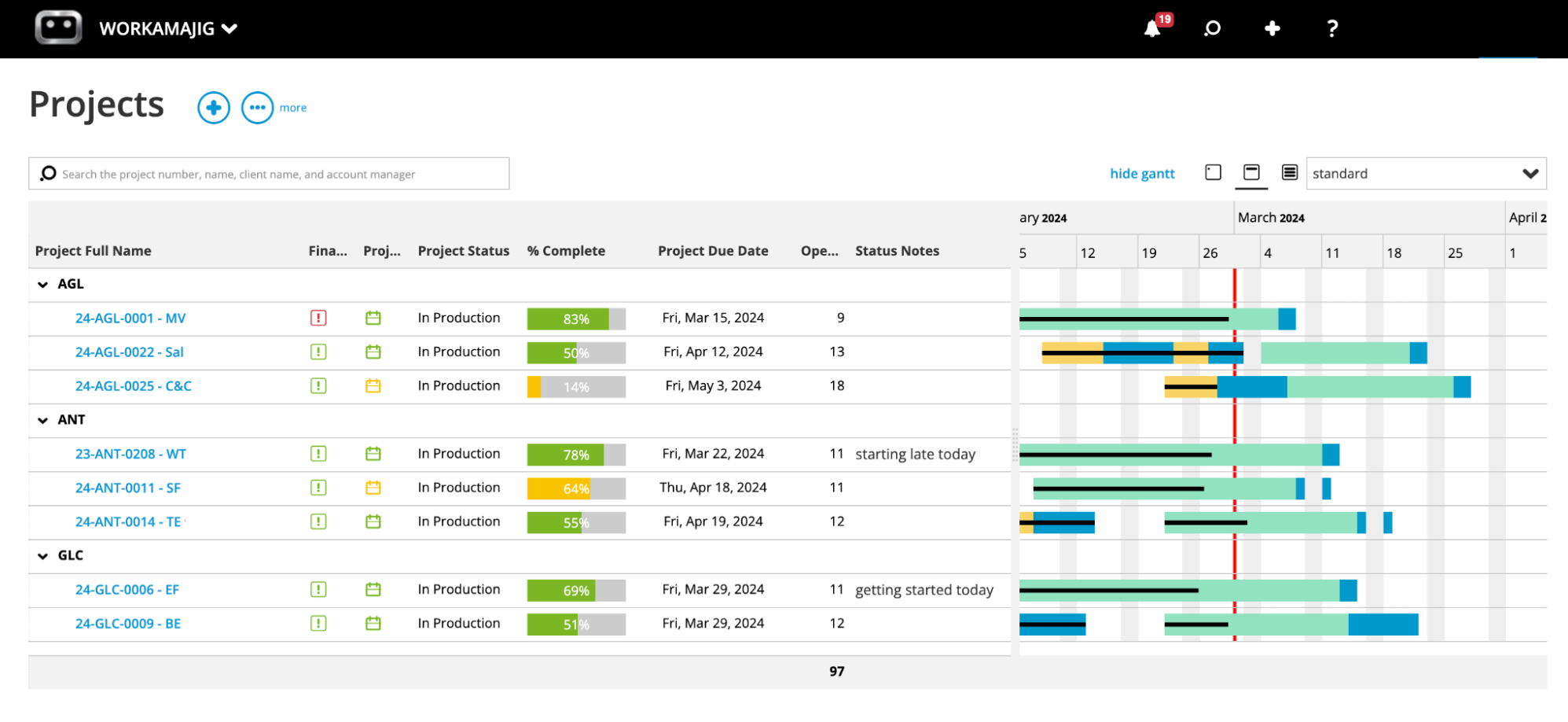
For example, in the screenshot above, you can see a red symbol [ ! ] In the MVC project’s Finance column; this shows managers the project has exceeded budget limits.
You can also see yellow warnings in the Project column for the “C&C website” and “SFY website” projects; this tells managers that projects are at risk of running over expected deadlines, but there’s still time to make adjustments before telling clients they’re behind.
This visually friendly, color-coded view makes project monitoring easier and shows managers exactly where to focus their attention. (Note that our system also sends notifications about projects with warnings so managers can intervene immediately and avoid bottlenecks.)
Managing New Projects & Project Scheduling
Our system’s CRM saves client contact information and converts new opportunities into sales leads. Your sales team can then work leads through the funnel; gathering extra details from clients, accessing staff schedules, and using our suite of financial tools to build estimates and close opportunities.
Note: Workamajig also offers Vendor Management so users can source partners or freelancers for projects, request quotes and receive bids, and include vendor costs in client estimates.
Taking the time to plan project tasks carefully while tallying in required resources and employees’ cost per hour lets your teams send more accurate estimates to improve project profitability.
.gif?width=906&height=510&name=gif%202%20(4).gif)
After a project request or opportunity is approved, our system automatically converts it into an active project — saving all the details (notes, spec sheets, etc.) so managers don’t have to do this manually, and staff members have all the relevant information to complete their work.
Then, managers can begin splitting the project into tasks and assigning team members and partners to each task. (A project could include three tasks or three dozen; there’s no limit here.)
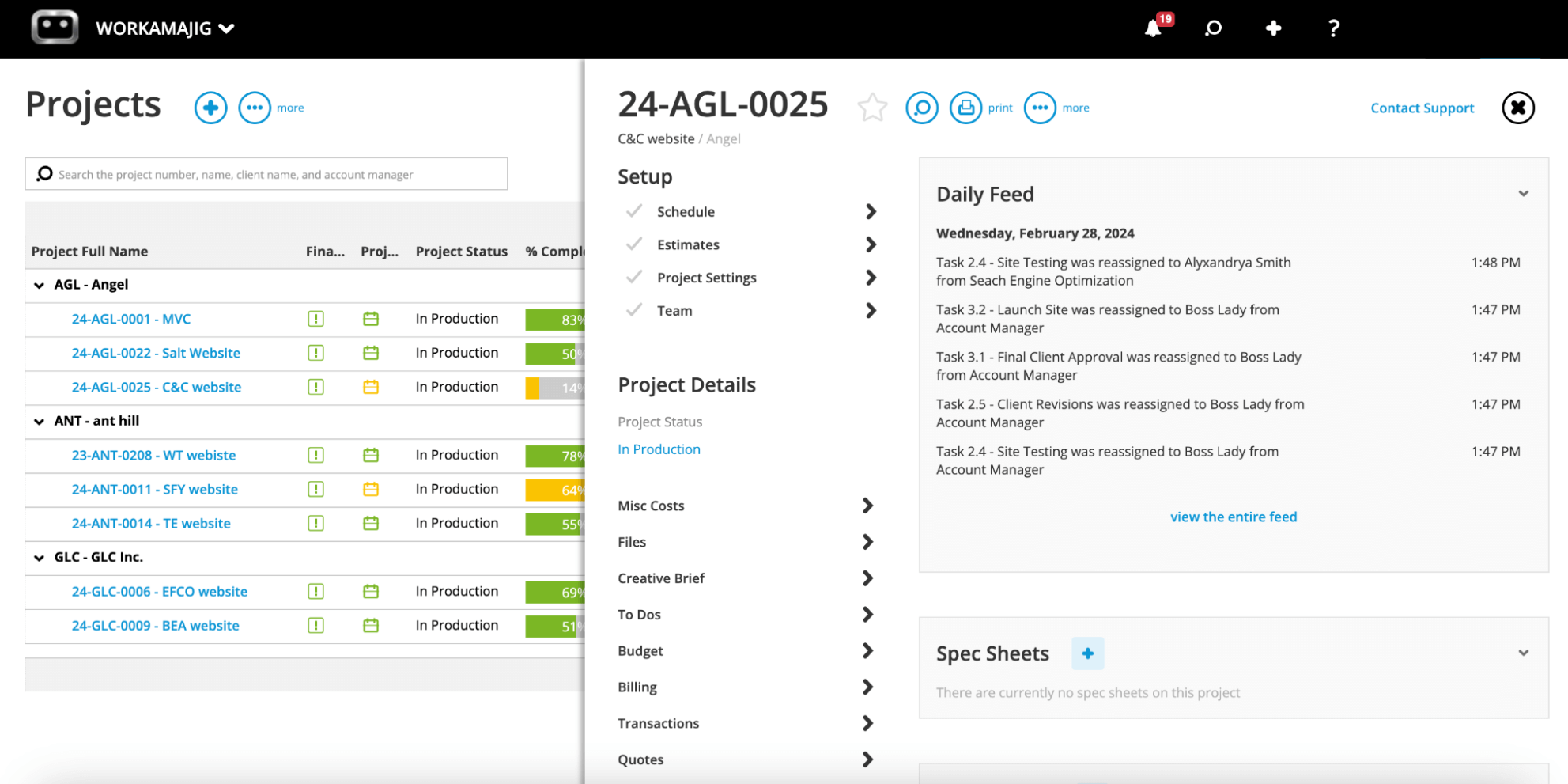
We allow managers to be more strategic with resource allocation, improving project time to market, and keeping employee workloads balanced.

Managers can get a full view of their staff schedule, including employees’ total number of hours they can work, the number of hours they’re scheduled for, and the number that remain.
In the screenshot above, you can see how the % Utilized column lets managers quickly see who is utilized most often and who needs work.
Then, managers can add staff members to task cards and specify the number of hours they’re allotting for each task. The staff schedule updates in real-time, so users can monitor work hours as they assign tasks and ensure no one is overloaded.
Managers can also create dynamic schedules to assign tasks automatically.

Then, managers can easily adjust staff schedules if employees call in sick or need extra hands to push a project over the finish line. It’s as easy as adding and removing users from cards; their scheduled hours update automatically.
This tool keeps employees happy by improving time management and preventing them from becoming burnt out or bored. It’s also helpful in planning tasks for the future and ensuring employees always have work to keep them busy.
While on the topic of scheduling and tracking employee hours, let’s move on to how our platform works on the employee side and cover our time tracking features.
Workamajig Features to Support Team Members
Today Dashboard
Our Today dashboard organizes employee tasks so they always know which work to prioritize and what’s ahead for the week. When logging into Workamajig, they instantly see this dashboard and all of the tasks in the queue for the day.
Employees can easily envision their day ahead, knowing when to work on what, and when they’ll have time for other obligations and breaks.
Then, task cards include all the details to complete work, the number of hours managers have allotted for the task, and the due date (re: above). Cards also contain quick links to project info like spec sheets, creative briefs, communications, etc.
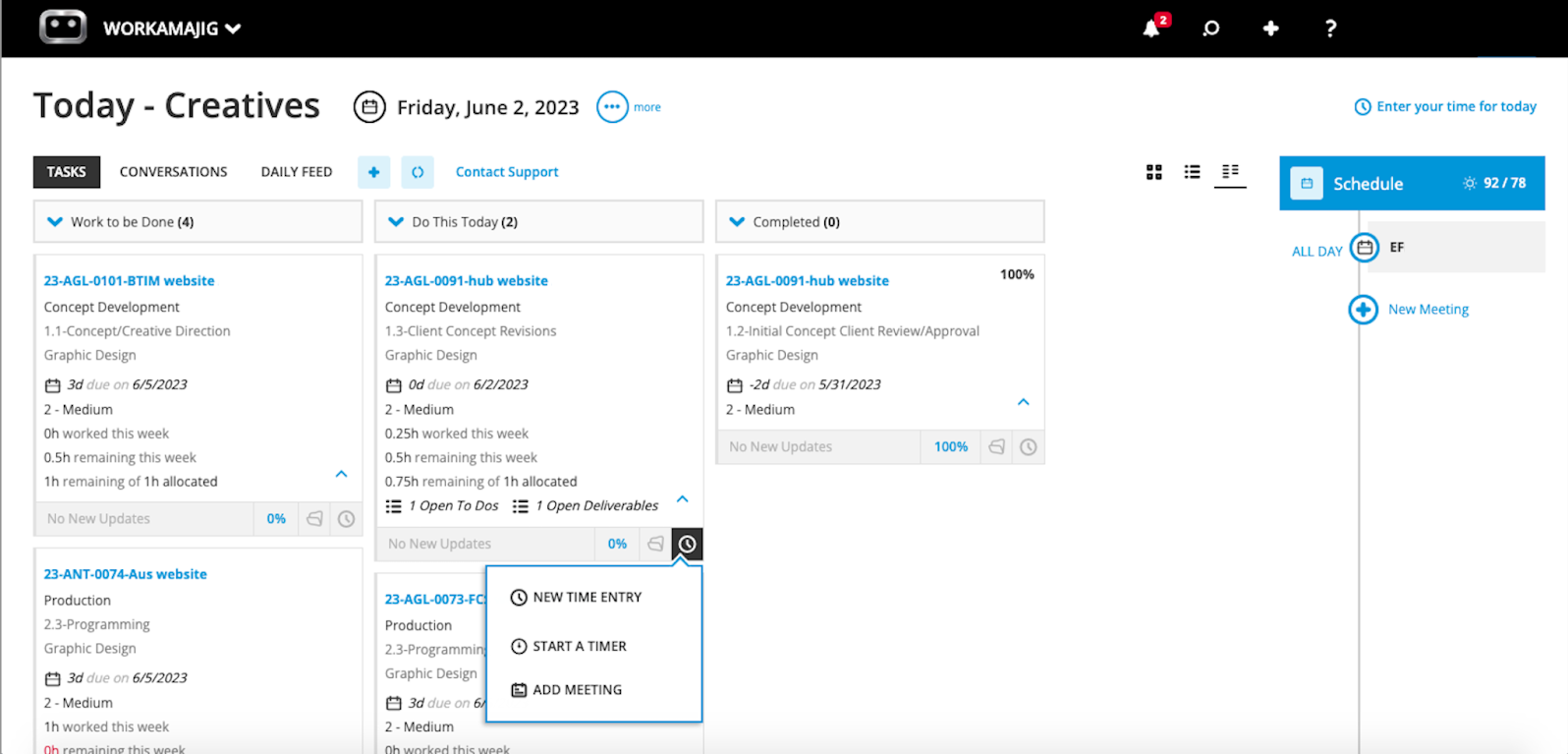
Time Tracking
Our platform makes time entry as simple as possible for employees.
|
You can read more about this process here: How to Track Creative Project Management Hours |
First, employees can track their time at the task level by entering the number of hours they worked or starting a timer to record time as they work.

Our native time tracker allows users to pause timers, toggle between tasks, and mark when tasks are complete. The timer functionality is also convenient for managers because it enables more accurate time tracking.
Instead of employees plugging “30 minutes” into a time tracking app or Excel spreadsheet, managers can check task timers and see how long tasks take to the second.
Note: Employees cannot adjust hours after tasks are marked as complete. Managers can account for extra project hours — say, if clients ask for edits to a design — by creating and assigning new tasks.
You can see how this feature works in our short (two-minute) demo below:
Another unique feature to simplify employee time tracking is our calendar integration. This tool allows employees to sync their calendars with Workamajig, which brings two main benefits:
- Time from calendar meetings is automatically recorded in Workamajig — our system can even connect meeting hours to projects. Users don’t have to add these events manually; they just have to confirm they attended. Managers can see a more holistic view of how many hours staff dedicate to projects.
- Managers can see employees' time off and other work commitments so they don’t overload staff members with project tasks when they have other obligations or are scheduled to be out of the office.
All employee time tracking data is tied to their hourly rates so managers can monitor project budgets as they assign tasks — seeing what specific tasks will cost to complete along the way and preventing projects from exceeding budgets.
Plus, our system shows when tasks are in progress and automatically updates project timelines as users mark individual tasks complete. Managers can see if projects are expected to wrap up sooner or later than expected (without having to message employees for updates).
Collaborative Tools (to Work with Team Members & Receive Client Feedback)
Employees can work and collaborate with others directly in task cards.
At the most basic level, employees can leave comments for managers if they have questions or want to relay details after completing tasks. They can also attach files and documents to task cards to share with others.

Our system also has internal proofing tools to collaborate on creative files and streamline the feedback process. Users can tag team members to review work; then, others can annotate creative files and leave comments requesting changes.
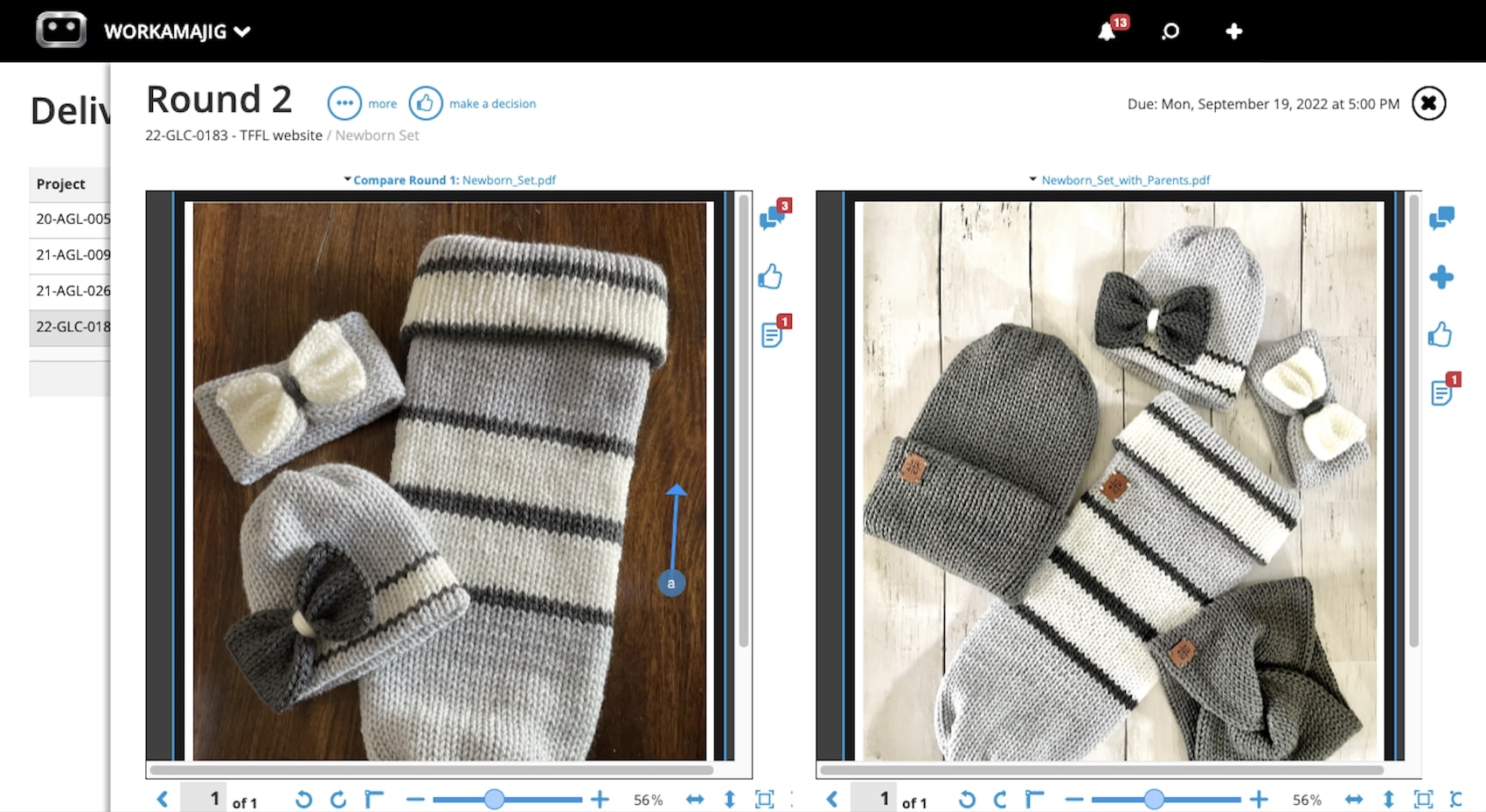
Our system integrates with dozens of creative applications so users can push files between systems and reference the version history after changes. Automated approval rules also make it so creative work reaches the right set(s) of eyes before being approved for client feedback.
After work is approved, managers can share deliverables with clients through the system. We allow you to create an unlimited number of client portal logins — where clients can request projects, track project progress, and view deliverables.
Then, clients can leave comments on files (as explained above) if they want to request any further changes.
Workamajig Agency Management Suite
We’ve already covered our CRM system and vendor and client portals — so before wrapping, let's review our accounting tools and agency insights.
Finance & Accounting
As mentioned, our accounting tools can replace external software, so you don’t have to use (and pay for) a system like QuickBooks or Xero.
For starters, our system lets you create and send client invoices, with all billable hours and line items. Workamajig supports various billing methods (time and materials, fixed fee, retainer, or media) so you can choose the right approach for different projects.
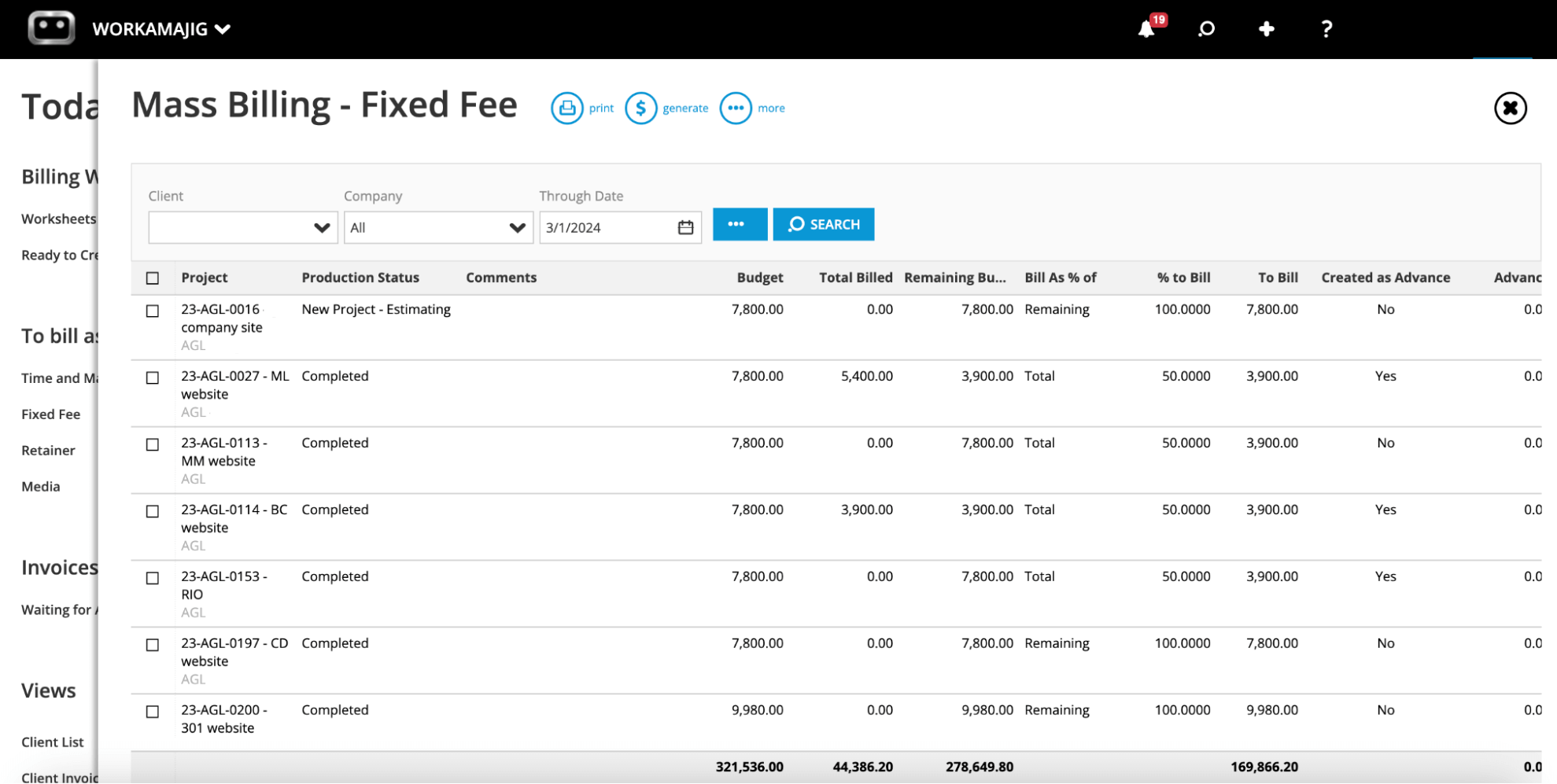
Our system can automatically defer advanced billings and prevent overstated revenue for more accurate financial reporting and cash flow visibility.
Workamajig also lets you reconcile and pay vendor invoices from our dashboard so you can send timely payments to partners and establish good working relationships.
In addition, our system lets you:
- Sync with employee spend cards so you can see credit card expenses in our system.
- Automatically generate and compile expense reports (with data from all purchases).
- Monitor project budgets and chargebacks.
Then we have financial reporting features to analyze costs, team performance, and project profitability — you can see forecasted revenue and expenses, along with profitability per service, client, creative team manager, or individuals. Then, you can brainstorm ways to improve cost savings and grow your bottom line.
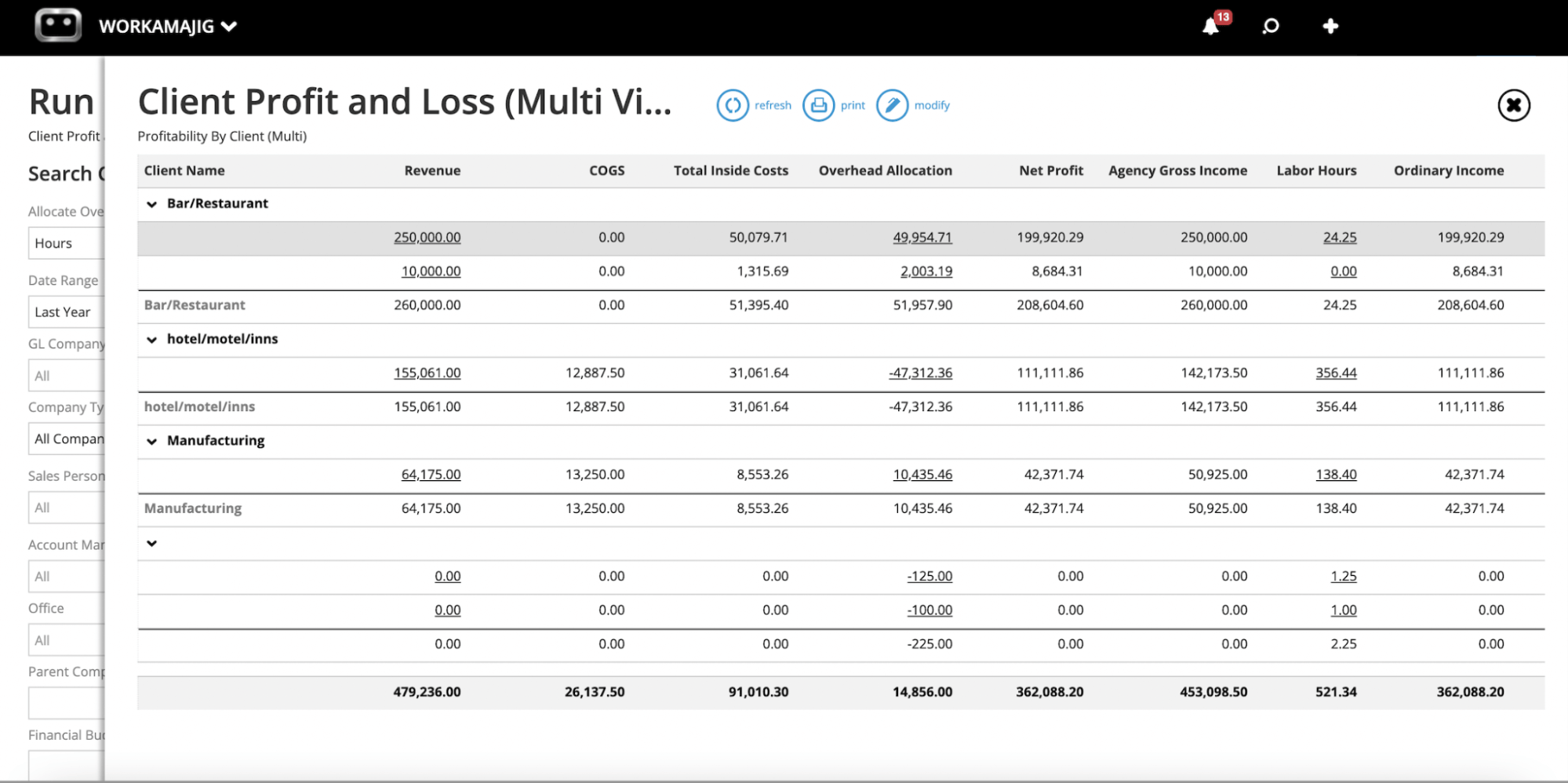
For example, you could establish labor budgets for individuals so at least 75% of their hours are dedicated to billable work. Or, you could dig into services or clients that aren’t driving a high profit and determine strategies to improve your margins.
|
Many creative teams overlook this financial piece. It’s only when they start adding costs to project hours that they realize they aren’t making money on client work — or worse, they’re spending more than budgeted and losing money. A project management tool that ties in project costs helps you avoid unprofitable work. At a higher level, it also highlights growth opportunities and ways to scale — so you can not just stay afloat, but thrive. |
Agency Insights
The Agency Insights dashboard provides a broader view of agency happenings, team productivity, and current projects.
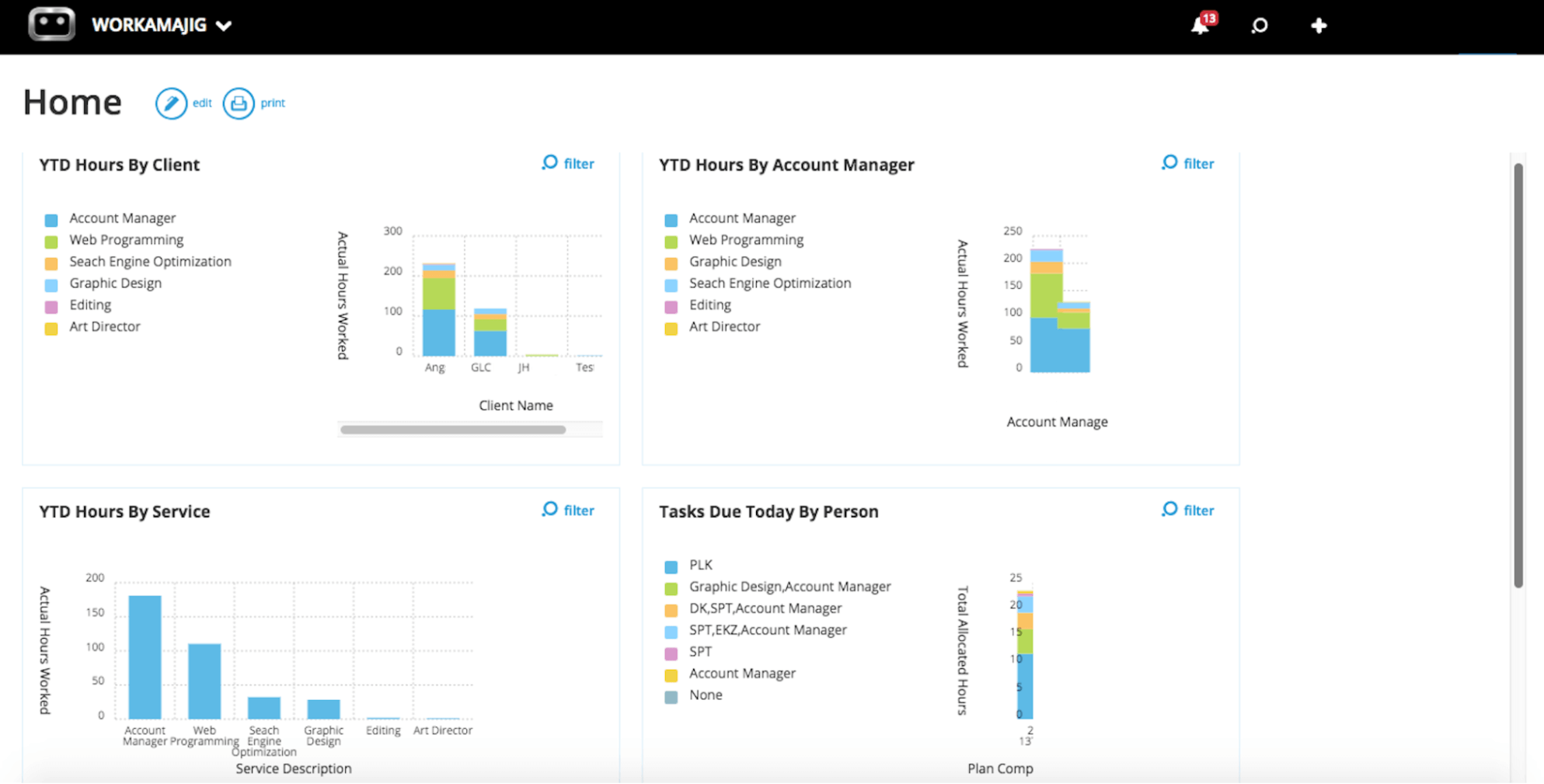
Managers can access reports to see what’s ahead for the day and coming week — this report shows the tasks, projects, or services teams are working on and the number of hours allocated per project or service. This helps you analyze your team’s time and compare billable time vs. non-billable hours; so you can prioritize projects that drive profit.
Managers can also analyze year-to-date hours by client, project, service, or team to see where they’re spending the most time, and which account managers and individuals are working the most hours. Then you can determine ways to shave hours and increase earnings from projects.
You can also create custom reports to analyze other metrics relevant to your projects or growth initiatives.
Check out our case study to learn more about how our client, LMG — a full-service marketing firm — used Workamajig time tracking to improve project profitability. (And actually see growth during the COVID pandemic!)
Plans & Pricing
We offer various packages to support different team requirements, including solutions for in-house teams, creative agencies, and enterprise organizations.
Pricing varies by package and team size and can be found here:
If you’re interested in learning more about our solution, you can schedule a free demo with our team. Afterward, we’ll game-plan training and onboarding so you can make the switch to our software without long downtimes.
2. Teamwork

Teamwork is another project management tool geared for creatives. The system also provides resource management and financial reporting, in addition to project management and time tracking.
The platform offers a Company Timesheets tool to monitor employee hours in a centralized dashboard. At the task level, it includes traditional time tracking tools (to log hours for tasks) and timers. It also includes a feature to remind employees to add hours if they don’t submit time with tasks.
Teamwork typically works with bigger brands (think Disney and Netflix) and has experience with creative agencies, marketers, IT teams, designers, architects, and more.
Features for Creative Teams
- Project time tracking solution — including Company Timesheets, timers & reminders
- Resource & workload management
- Project intake forms
- Project management, including tasks & subtask management, and customizable project monitoring dashboards
- Project templates & automation tools
- Budgets
- Invoicing
- Retainers
- Expense management
- Collaborative tools for teams, including proofs, annotations, and file sharing
- Reporting dashboards
- Client management solutions
- Integrations
- Mobile apps for iOS & Android
Pricing
Teamwork offers tiered packages:
- Free — a very limited package to give a preview of how the platform works.
- Starter — $8.99/user/month — grants access to Teamwork’s most basic features and includes time tracking. This plan requires a minimum of three users (a minimum monthly cost of $26.97).
- Deliver — $13.99/user/month — with “more robust project management” features. This plan also requires three users (a minimum monthly cost of $41.97).
- Grow — $25.99/user/month — this package unlocks access to Teamwork’s Company Timesheet functionality. This plan requires a minimum of five users (a minimum monthly cost of $129.95).
Teamwork also offers custom packages for enterprise teams.
We (along with Teamwork and platform reviewers) recommend the Grow plan because it gives access to the Company Timesheets feature. However, the lower plans also offer access to the more basic time-tracking tools.
You can read more about Teamwork on their site.
3. Productive
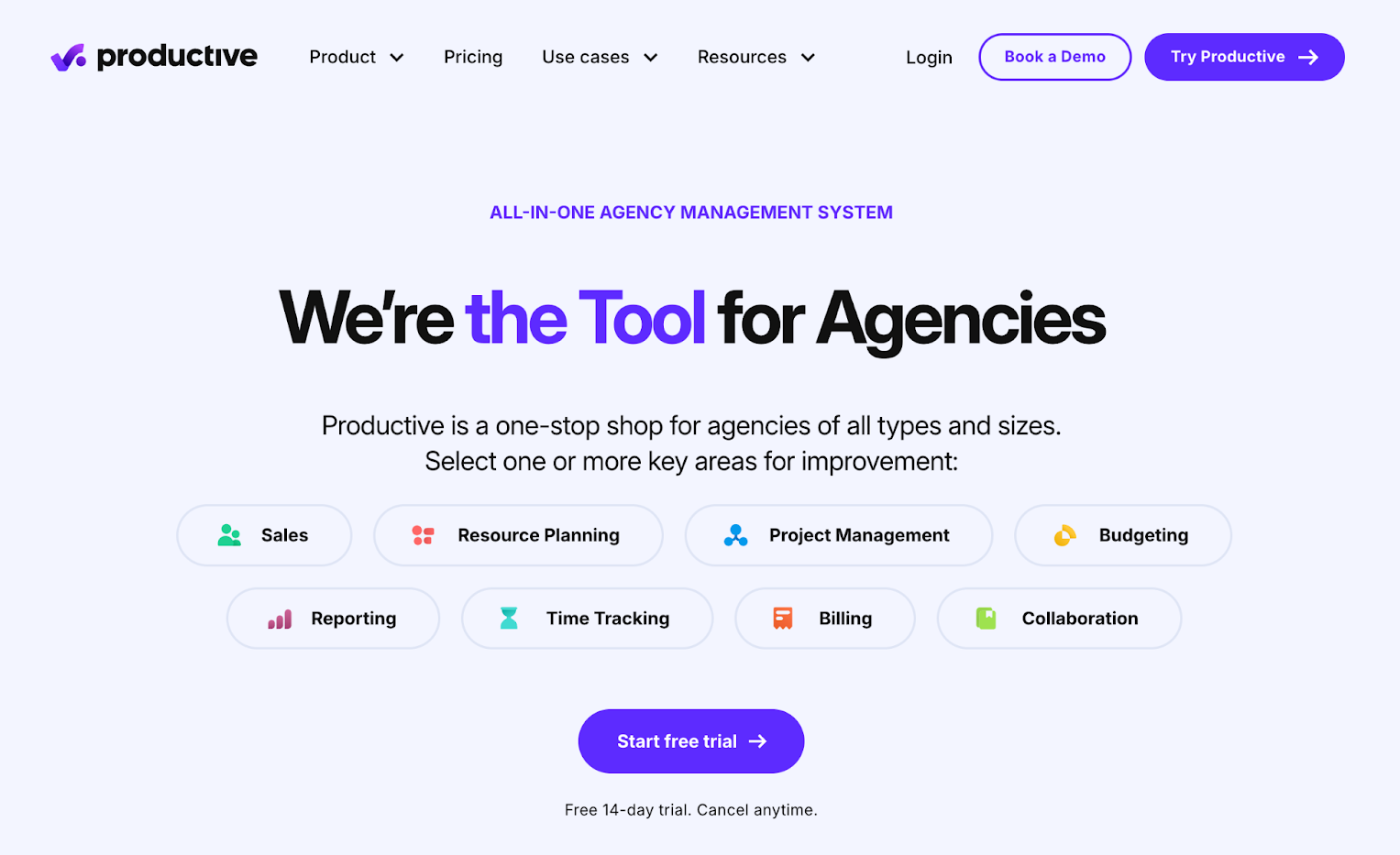
Productive is an agency operations tool with project management, resource planning, budgeting, time tracking, CRM, financial reporting, and more — to manage all aspects of your operation in one system. They typically work with smaller teams looking to scale operations.
It’s worth noting that some of Productive’s functionality is app-powered; notably, the financial reporting module is rather basic. Teams are recommended to use, and integrate, an external accounting system to unlock the full potential of Productive’s invoicing tools and financial reporting data.
The time tracking feature, however, is quite powerful (but still simple to use).
The tool lets managers:
- Review & approve PTO requests
- Review & approve billable time entry requests
- Track project hours & choose which line items to include in invoices
- Track billable hours per project & analyze project profitability
The system lets employees plug hours in manually, or use timers to track time. Employees can also integrate their calendars to pull hours from meetings and other work events (and the system offers automatic time tracking for calendar events).
Managers can view employee time reports by day, week, or calendar month, and track time within task cards.
Features for Creative Teams
- Time tracking — with timers, calendar integrations, automatic time tracking, and manager reporting tools
- Project management
- Budgeting
- Billing
- Sales
- Resource planning
- Reporting
- Documents (to create shared docs & collaborate with teammates)
- Open API (to integrate with outside systems)
- Mobile apps for iOS & Android
Pricing
Productive offers tiered plans, each with different features and levels of support. You can meet with the Productive team before onboarding if you’re not sure where to start; their team can help choose the package that fits your needs, customize the software for your workflows, and set up integrations.
Note: Reviewers (and the Productive website) suggest choosing the Ultimate plan to unlock all critical agency management tools.
Here’s a quick look at their offerings:
- Essential — $11/month — advertised as their package for “getting started with end-to-end agency management.” This includes basic project management tools and includes time tracking functionality (but does not include time off management or invoicing features).
- Professional — $28/month — this plan includes more advanced project management and time tracking features, including the tools mentioned above and automated time off approval flows.
- Ultimate — custom quote — this includes all features from the Professional plan, plus more advanced time tracking, revenue forecasting, expense approvals, HubSpot and Slack integrations, and more.
Productive also offers custom plans and pricing for enterprise businesses with over 50 employees.
You can read more about Productive's time-tracking features on their site.
4. Scoro

Scoro is another agency management tool with project management, time tracking, resource management, and financial reporting. However, like Productive above, Scoro’s platform is mostly app powered — they suggest integrating your CRM, accounting tools (and even other project management tools) to support their platform’s core functionality.
Their platform serves as a hub to integrate data and manage each aspect of your agency operations. It helps teams use different tools in sync and organize operations, but it doesn’t necessarily help shave software costs and consolidate your tech stack.
Scoro’s native time tracking tools work a lot like the other competitors we’ve covered. They offer a timesheets feature for users to add manual time by task. Alternatively, users can record time on task cards, by plugging in hours or using the timer functionality.
The platform offers advanced resource planning so managers can assign team members to tasks strategically and avoid burnout. It also has invoicing tools to add billable hours and line items to client invoices.
Features for Creative Teams
- Time tracking — with timesheets, timers, resource planning, and smart invoicing tools
- Project management
- Quoting and budgeting (to create proposals & estimates)
- Cost management
- Retainers
- Reporting dashboards
Pricing
Scoro offers tiered packages with different features per plan — their website recommends the Pro plan because it includes all recommended work management tools (including time tracking).
Note: All packages require a minimum of five users, and Scoro charges extra for custom modules and their Sage Intacct add-on. Users may also be subject to cancellation fees if they do not notify Scoro of cancellations at least 30 days before subscriptions are scheduled to renew.
- Essential — $26/user/month (a minimum cost of $130/month). This is the most basic package; it does not include time tracking so we suggest skipping this plan.
- Standard — $37/user/month (a minimum cost of $185/month) — this plan includes Scoro’s time tracker but still lacks key features, like accounting integrations to power invoicing.
- Pro — $63/user/month (a minimum cost of $315/month) — the recommended plan to access advanced work management and time tracking tools.
Scoro also provides custom plans for enterprise teams; users have to contact Scoro for more information if they’re interested in this option.
Check out the Scoro site to read more.
5. My Hours

The last option on our list — My Hours — is a super lightweight project management software with time tracking that’s popular among creatives. They offer a free plan, and a basic package that costs $8/user/month.
This software solution lets you create projects, tasks, and to-do lists; assign team members to tasks; track hours by task. Managers can create weekly timesheets with all of the week’s tasks, and then employees can add time into the sheet or record time on task cards.
My Hours also offers invoicing tools to create detailed client invoices, and reporting tools to analyze employee hours and costs by client, service, project, (and more).
But note (again) this is a very “entry-level” project management tool with time tracking. It doesn’t include advanced features like project intake forms or resource planning, and the reporting functionality is rather limited. The product still requires you to use outside accounting software and integrate other systems to support the core functionality.
We’ve saved them for last on this list because they might be worth considering if your budget is tight and you want to get started with a time tracking solution (perhaps you’re working in a small business or agency setting).
However, this is not the most recommended option for growing teams because it lacks features to manage each stage of project planning. You’ll eventually outgrow this and need something more comprehensive.
Features for Creative Teams
- Weekly timesheets — with timers on task cards & daily reminders
- Projects, tasks, and to-do lists (Note: You can only assign tasks to other team members in the paid plan)
- Project monitoring & organization — to ensure projects don’t exceed timelines or budgets, and monitor project profitability as you work
- Monthly budgets — with budget alerts
- Client billing — including labor costs & billable rate per tasks or team member
- Reporting dashboard — including expense reports and client P&L reports
- Time analytics
- Team payroll
- Integrations (via Zapier)
- Mobile apps for iOS & Android
Pricing
My Hours offers a free plan for individuals and small teams. It allows users to add unlimited projects and clients, track project and task hours, set billable rates, and access the reporting dashboard.
The upgraded plan ($8/user/month) includes invoicing tools, features to automate workflows, and access to the QuickBooks integration; in addition to other perks, like budget alerts and extra reporting insights.
You can read more about My Hours on their website.
Getting Started
Workamajig is a comprehensive project management tool designed with everything creatives need to plan and track projects strategically.
Curious to see if Workamajig is right for your teams? Schedule a free demo to explore the platform with one of our experts.


